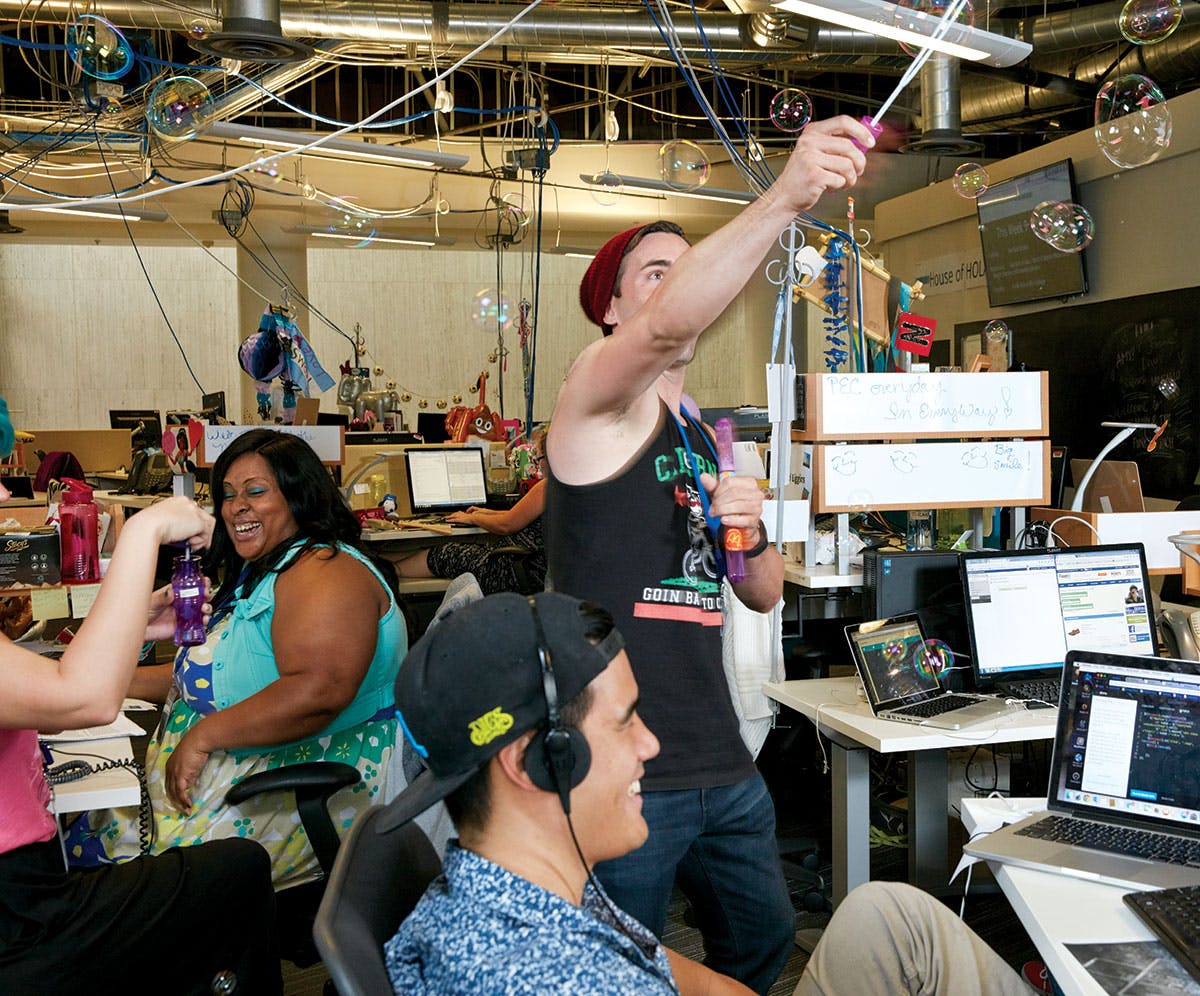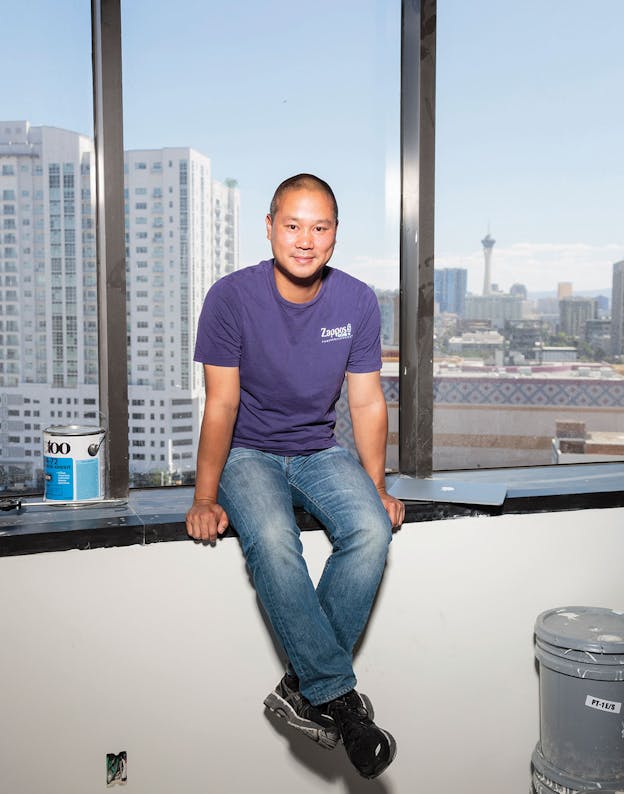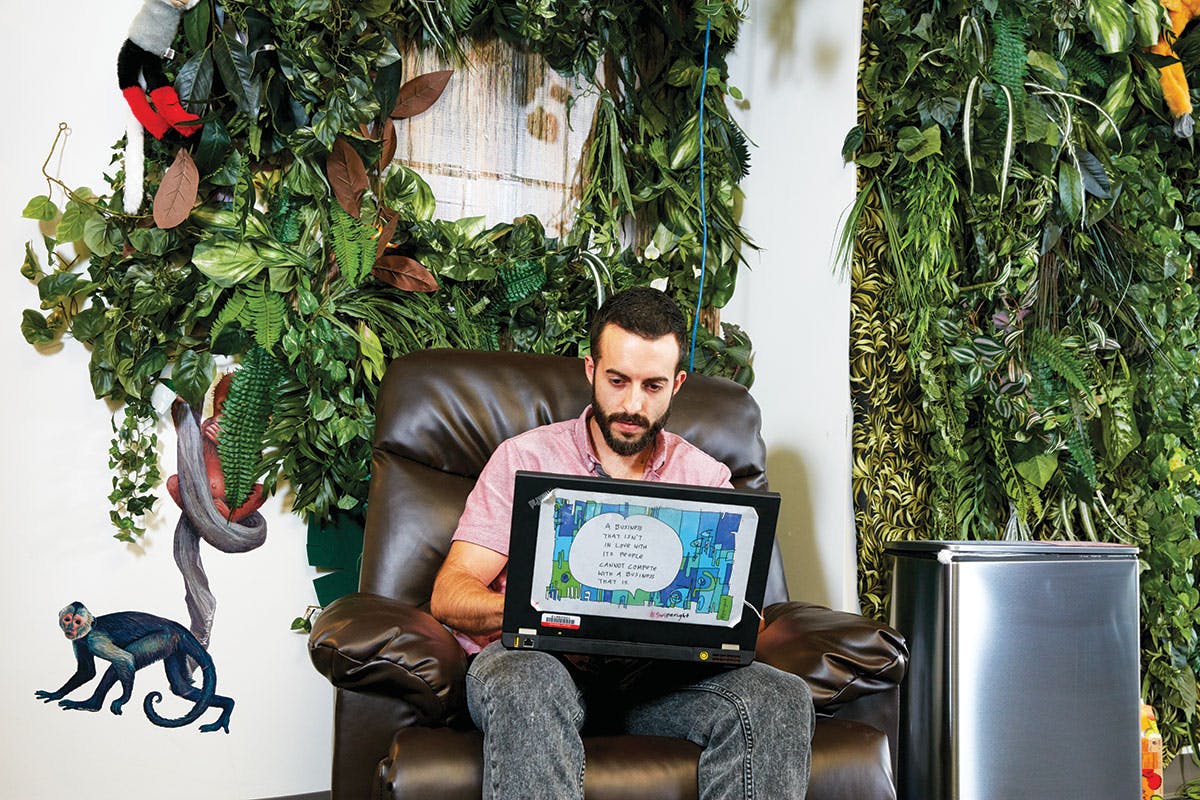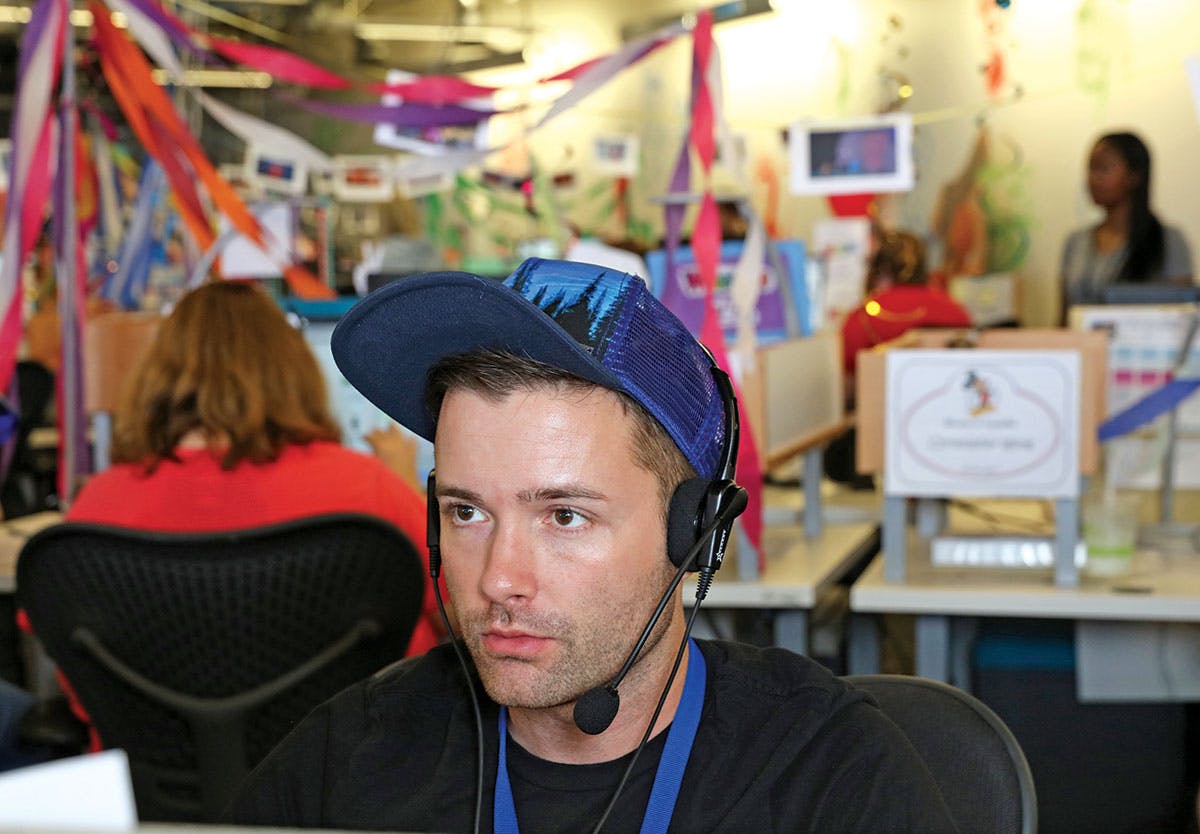Tony Hsieh, the CEO of Zappos, the online shoe and clothing store, lives in a trailer park in downtown Las Vegas. The Airstream Park, as it’s called, occupies about half a city block, surrounded by a tall fence crowned with barbed wire and punctuated with palm trees. When I arrived in April, Adirondack chairs, picnic tables, and a colorful assortment of portable seating encircled a pair of fire pits. On one side of the park was a low stage, directly opposite a large two-story Airstream, known as the Llamamobile, equipped with a roof deck and a third fire pit and decorated with a mural of a lone llama grazing in a limitless lush green field. Next to the Airstream, modified shipping containers painted in primary colors revealed a laundry room, kitchen, and a pantry stocked with cases of Fernet, an Italian digestif. Scratched into a concrete step was the word “Llamalopolis.”
Hsieh sleeps in a 22-foot Airstream, and the park serves as his preferred location for hanging out with friends and colleagues, for entertainment, and for much of his business life. In personal style he is aggressively casual, wearing a daily uniform of blue jeans, black sneakers, and a Zappos T-shirt. Everyone calls him Tony. Although he is reserved and quiet, Hsieh clearly enjoys a good party. In his memoir, Delivering Happiness, he wrote that one of the primary reasons he sold his first company, LinkExchange, to Microsoft in 1998 was that running the business had ceased to be fun. So it comes as no surprise that the atmosphere Hsieh has created around himself in Las Vegas, where he moved the company from San Francisco in 2004, is aggressively festive. “South by Southwest meets TED meets Burning Man,” he told me. “But as a lifestyle, not a festival.”
Although Hsieh did not found Zappos—he was an early investor and joined the company as CEO in 2000—he encountered the same sense of connection and tribal identification in running the online shoe company that he had once felt at raves. His new company became his tribe, and although there were some tough times during the early years—the dot-com crash, layoffs, salary reductions, and extremely long hours—Hsieh’s focus was always about making the company culture as positive and caring and fun as possible.
That “tribal” focus remains strong today, and the company’s culture is decidedly wacky. An unofficial dress-code of T-shirts and sneakers predominates in its expansive open-plan offices; large tattoos, high-fives, and hugs abound; severed neckties, liberated from stuffed-shirt visitors, adorn a wall behind the lobby reception desk. Conventional job titles hardly exist, and top executives are referred to as “monkeys”; assistants, on the other hand, are “ninjas.” Stuffed animals, toys, and murals decorate most surfaces. Upbeat music blares from speakers in the headquarters’ courtyard. Zapponians, as the employees call one another, like to talk about “work-life integration” rather than work-life balance.
In recent years, however, Hsieh’s experiments with corporate culture have become more philosophical. About three years ago, he introduced an arcane management system, called Holacracy, that baffled many longtime Zapponians. Then, in March, he sent out an email to all 1,443 Zappos employees. “This is a long email,” he wrote. “Please take 30 minutes to read through the email in its entirety.” Ominous words to see in a message from one’s CEO. Were layoffs coming? Was Hsieh resigning? Was Amazon, which acquired Zappos for an estimated $800 million in 2009, finally going to impose its famously cutthroat corporate culture? No, it was nothing like that, though the news was certainly dramatic. After four paragraphs salted with esoteric terms such as “Teal organization,” “self-organization,” and “Glass Frog,” Hsieh finally reached the point: “As of 4/30/15, in order to eliminate the legacy management hierarchy, there will be effectively no more people managers.”

Zappos, Hsieh explained, was moving from “Green” to “Teal,” the next stage of its collective corporate evolution, and managers were no longer valued by the company. To make the transition easier, former managers would be permitted to keep their salaries, though not their responsibilities, through the end of 2015, if they chose to find new roles with the company. The email landed like a bomb at Zappos. People inside the company were upset. People on the outside were just confused, and a flurry of perplexed news items appeared in the business press. Clearly, some kind of corporate revolution was underway—though exactly what all this meant was far from obvious—and Hsieh wanted to make sure that his employees were on board. For those who were not, a new version of Zappos’s famous “offer” would be available. New Zappos employees typically undergo several weeks of training and education in the culture and traditions of the company, a period that includes at least one week working in the call center, or CLT (Customer Loyalty Team). At that point, new hires have the option to accept the offer: a no-questions-asked $3,000 payment if they’d simply like to walk away. In the March email, Hsieh asked everyone in his company to read Reinventing Organizations by Frederic Laloux—generally referred to as “the book” by Zapponians—and to make their intentions known by April 30. If they decided to leave, they would receive a minimum of three months severance, or one month for each year on the job.
What was “Teal,” and why was it better than being “Green”? And what did it mean for an online retailer with annual sales of more than $1 billion, that fills 280,000 orders per week, to be “self-organized”? These were open questions, and no one at Zappos, including Hsieh, claimed to have the answers. But Hsieh had forcefully positioned himself at the vanguard of a growing movement that hopes to bring about the end of corporate management as we know it.
After I settled into the trailer where I would be staying for the next several nights, I walked around the park, where I met several bearded men. One was doing a handstand. They were working on a movie called Poor Boy. Lou Pucci, who had a long beard and ripped jeans exposing a painfully fresh tattoo on his leg, told me that he and his friends were trying to hang out here in the park as much as possible, because out there (he pointed vaguely toward the casinos in the distance) people were trying to corrupt them. “In the last couple of weeks I got engaged,” he said dramatically, swaying slightly. “And I got this big tattoo!”
Two of Hsieh’s close colleagues, Jeanne Markel and Maggie Hsu, arrived to give me a tour of the Downtown Project, a real-estate development and business incubator that over the last three years has transformed a formerly derelict section of Las Vegas known as Fremont East. The DTP, as everyone calls it, comprises about 60 acres of real estate, almost 300 buildings, and includes about 50 small businesses as well as various startups. The project was born about the time Zappos moved from Henderson, a suburb 15 miles outside of town, into the former Las Vegas City Hall downtown. Employees weren’t very enthusiastic at first, since the surrounding area was rundown and dangerous, so Hsieh decided to invest $350 million of his own money to transform the neighborhood. The DTP is not technically a part of Zappos, though in practice it’s often hard to tell the difference. Markel has moved back-and-forth, but now works at Zappos, basically as Hsieh’s shadow, while Hsu works for DTP. From what I could tell, Hsieh’s enthusiasm for his urban experiment seems to outstrip his interest in selling shoes.
After wandering through a hip collection of retail establishments, including a vinyl record shop, an independent bookstore, and several restaurants, we arrived at the large open courtyard of the Zappos headquarters, a squat, almost Brutalist, building. A petting zoo had been installed for the afternoon. After half an hour watching small children toddle around in cages chasing exotic armadillos and capybaras, I headed back to the Airstream Park, stopping first at a shopping center called the Container Park, which was guarded by a giant praying mantis perched on what appeared to be an armored personnel carrier, to grab a couple of tacos.
Back in the park, I selected a Corona from the communal pantry and deposited a dollar in a huge lifelike spotted piggybank. I sat down in an Adirondack chair near a fireless fire pit and chatted with a red-bearded Zapponian named Tyler Williams as he set up microphones and amplifiers on the Airstream stage for a biweekly jam session called Open Air. Williams, whose job title was “fun-gineer,” spotted my beer, told me I had the right idea, and got one for himself. More musicians arrived, and I was befriended by Gio, a charming six-and-a-half-year-old boy who lives in the park with his mother and sister. As I spoke with him, I noticed Hsieh walking back-and-forth, back-and-forth, across the ovular expanse of asphalt in the center of the trailer park. He was deep in conversation with a thirtysomething woman wearing shorts and a T-shirt. She did not look happy. Not at all. Catherine Cook, who works for Zappos in marketing and public relations, showed up, and then so did Markel and Hsu. Shadows were getting long, and people were starting to do sound checks. A blow-up movie screen had appeared behind the stage, and an array of stage lights had been set up as well. Hsieh was still walking back-and-forth, deep in conversation with the unhappy-looking woman. I met a Zapponian named Laura Krosky, who started in customer service and then moved to public relations. She was a marketing ninja for a while, and then answered Hsieh’s email. Before joining Zappos she worked as a blackjack dealer at Planet Hollywood.

Evening was coming on when I met the woman who had spent the previous two hours in the walking meeting with Hsieh. Her name was Rachel Murch. I mentioned I was writing about the changes at Zappos and she gave me a sharp, skeptical look and said, somewhat cryptically, “Or whatever all this will mean for Zappos.” Around 10 p.m. Hsieh and several other Zapponians went up to the top of the big Airstream for a meeting. I could see what they meant by work-life integration. By the time Lou Pucci took the stage and sang “Mary Jane’s Last Dance,” the band had swelled. A guy named Joey was playing trumpet, and another named Daniel was tearing it up on an electric fiddle. A lovely dark-haired high school girl who sang and played guitar announced from the stage that she had an algebra test tomorrow, so she had to go home. I saw Hsieh pick up a tambourine and heard a couple of straight-laced guys—clearly not Zappos employees, possibly Germans—making plans to go sky diving with a slick start-up dude sporting stiff gelled hair and a leather jacket. From my conversations with various Zapponians, I gathered that this idyllic scene was typical of life in Tony Hsieh’s magical kingdom. Work was fun, which is good, because people never really stopped working. Meetings might be scheduled at 10 p.m. on a Sunday, in the middle of what appeared to be a party but was really just an extension of the all-encompassing Zappos corporate culture. Was this what Hsieh meant by self-organization? Did going Teal mean selling shoes and designer purses plus open mic sessions and Fernet shots?
I pondered these questions as I headed for my trailer. Right then I saw Murch approach Hsieh. They spoke for a moment and then walked away from the stage. I sensed the beginning of another walking meeting. The next morning I checked Hsieh’s public Evernote log, on which he memorializes his emails and meetings and often includes the number of steps he’s taken on a particular day. The previous day he had logged 12,916 steps. Last night he simply recorded “steps.”

On my second day in Las Vegas, I reported to the lobby of the Zappos headquarters building to meet my guide, Josh Pedro. Like many other employees, Pedro began his career in CLT, working the phones. After a few years, he moved to ZCON, the Zappos concierge team, which handles tours and the reception of vendors and guests. More recently, he had moved to the marketing team, which handles public relations. After checking me in at the front desk, we stepped out into the bright courtyard. “Tainted Love,” by Soft Cell, was blaring from outdoor speakers.
As we walked through the former city hall, passing stuffed giraffes and a tiger, Pedro explained the basic tenets of Zappos culture, which can be summarized by its ten core values, the most important of which seemed to be “deliver WOW through service,” “pursue growth and learning,” “create fun and a little weirdness,” and “embrace and drive change.” Naturally I had read about these core values before I arrived, and I had read Hsieh’s book, in which he argues that a company’s brand is best understood as a reflection of its culture. Even so, most corporate (and nonprofit) mission statements might as well be written on toilet paper in the chief executive’s bathroom. Not so at Zappos, which is renowned for its commitment to customer service. Shockingly, everyone also seemed to believe in the other values. The company encourages its 600 CLT representatives to make personal connections with callers, and to send flowers, cookies, or thank-you cards. Desks were adorned with balloons, wacky signs, streamers, stuffed animals, and other toys. Some walls were covered with murals painted by artistic employees; others advertised the company’s generous benefits packages as well as convenient services such as the on-site haircuts, laundry pickup and delivery, car washes, and oil changes. Most people wore sneakers and T-shirts, of course, but dry cleaning and shoe shines were available as well. Each floor seemed to have multiple kitchens and break rooms, vending machines, and mini-fridges filled with free snacks. Everywhere we went, I saw signs of creativity, fun, and moderate weirdness. People called out greetings to one another, and I saw multiple hugs and high-fives. Almost everyone was smiling. At first the earnest happy vibe felt slightly creepy, but I soon grew to appreciate it. The business of selling things over the internet was going on all around me. Orders were being placed on the web site, but that’s invisible when you walk the floor. People sat at desks and talked on the phone with customers, or they emailed or chatted with customers. Also invisible were all the warehouse personnel, who used to work in Kentucky for Zappos but now all work directly for Amazon—and, to judge from news reports, that doesn’t sound like very much fun at all. Most of the people I spoke to over the course of the next several days were extremely enthusiastic about the future of Zappos. But there were signs of trouble. At one point, I saw a samizdat Post-it in the elevator. It read: “sli.do/teal have something to say?” Later, when I went to the URL, I found signs of secret Zappos sadness:
Anonymous: “What on earth were they thinking having all of these changes going on at once? Why not hammer out one thing at a time?”
Anonymous: “I’m afraid to speak up in my circle because I’m afraid my lead link might retaliate. What resources are available to me?”
Anonymous: “Upvote this if you don’t trust Tony anymore.”
When the deadline arrived on the last day of April, 14 percent of the company, 210 people, took the offer. Twenty of them were managers, I was told, out of a total of 246. It was a difficult day. Tear-stained faces replaced the typical smiles on the Zappos campus.
My first formal interview at Zappos was with John Bunch, a tall and lanky former professional poker player who joined the company five years ago as a software developer. He told me he had been on a typical management path, running a team of other developers, when he saw an announcement for a new job shadowing Hsieh for a year as a technical adviser. Soon Bunch was taking on other projects, one of which was a pilot Holacracy program. Bunch quickly became a strong advocate, and when the decision was made to roll out Holacracy to the rest of the company, he led the effort.
Many of the reactions in the business media to the changes at Zappos have focused on Holacracy, probably because it’s a well-established brand, but that’s a bit like mistaking the finger for the moon. It is, in fact, just one example of a growing movement, driven largely, but by no means exclusively, by the technology industry, that seeks to apply insights derived from evolutionary biology and psychology, systems and chaos theory, as well as New Age spirituality and postmodern philosophy, to corporate management practices.
Of course, business school professors have been proposing far-reaching programs to reform the workplace, especially the corporate workplace, for as long as we’ve had business schools. They study successful companies, write up case studies, and publish their results in publications like the Harvard Business Review. Then they write inspirational how-to books. Entrepreneurs and heroic CEOs, like Hsieh and Jack Welch, also write best-selling “how I did it” books. Every now and then, a management guru like Clayton Christensen strikes a chord, and suddenly everyone is talking about “disruption.”
Another stream of the corporate reform movement grows out of a general dissatisfaction with bottom-line materialism and a lingering sense that devoting one’s life to the pursuit of naked profit leaves people emotionally exhausted and spiritually barren. You can see its roots as far back as the 1920s and 1930s, when Mary Parker Follet wrote a series of influential articles on the subject. Companies like Ben & Jerry’s and Patagonia came of age in the 1970s, and their founders strove to align their business strategies with their moral values. Nowadays “purpose” has emerged as a bankable buzzword.

Often these management trends are simply fads, voguish recipes for business success that do little but exchange one set of buzzwords for another. But every couple of decades, a new generation of management theorists comes along and applies the latest and greatest scientific paradigms to the corporation. The current wave of scientific management has been bubbling up for years. Managers have tried to make large slow-moving companies function like small agile startups. They’ve eliminated luxurious corner offices and imposed open-plan workspaces on middle managers and executive teams alike. Offices where the CEO occupies a regular desk like anyone else are now commonplace, and these changes have introduced a more casual and superficially democratic ethos to corporate America.
What’s interesting about the Zappos version of corporate reform is that it combines several familiar tropes of management theory. Hsieh is a successful entrepreneur and a heroic CEO and an inspirational “happiness” guru (his book’s subtitle is A Path to Profits, Passion, and Purpose) who happens to be fascinated with ideas derived from network theory and evolutionary biology, with systems that are at least partially self-regulating and self-organizing, like ant colonies and, to some extent, cities. Thus, it’s not really surprising that he would be attracted to a management technique like Holacracy.
Holacracy is, at its core, a commercial product. It was created by Brian Robertson, the founder of a defunct startup called Ternary Software. Robertson bills Holacracy as an organizational operating system, “social technology.” The word itself, a coinage derived from Arthur Koestler’s concept of the “holon” (sort of like a fractal, a whole that is part of a larger whole), is a registered trademark, and though the system is nominally free to use, companies must license Robertson’s proprietary web-based application, called Glass Frog, on which the system depends for its strict implementation. And by strict, I mean strict. A Holacracy meeting follows a rigid script, with a facilitator who directs conversational traffic. No chitchat allowed, no crosstalk. It is a model of efficiency but also inflexible and highly abstract and stultifying to describe in detail. The point is that all meetings follow the script, and decisions and action plans must be recorded in Glass Frog.
In general terms, though, the idea behind Holacracy is simple enough and follows from a few assumptions, such as the belief that people are inherently creative. Another is that old-fashioned management hierarchies stifle innovation, because they naturally generate informal rules and cliques of powerful insiders, which is inefficient and demoralizing, so a new and better system would be founded on clear, transparent rules. Even better, the rules should be flexible and adaptable, so governance procedures should be incorporated into the system.
So instead of having jobs, in Holacracy people have roles. Each role belongs to a circle rather than a department, and circles are guided not by managers but by lead links. Circles overlap, and individuals hold many different roles. Of course, in traditional organizations, individuals occupy a variety of roles as well, but this is often an implicit and de facto state of affairs. Holacracy codifies that reality, so that dynamic roles replace static jobs. Authority becomes distributed, rather like packets of information on the internet. People being people, conflicts and problems will naturally arise, and so a mechanism—“sensing a tension”—must be devised to handle conflicts and resolve them. A tension is not necessarily a bad thing, however. Tensions might arise from anything that prevents getting work done, any gap between what is and what ought to be. As its adherents often say, in Holacracy “tensions drive everything.”
The tension I sense in many readers right now is that this all sounds unnecessarily confusing and abstract. It sounds like something invented by a software engineer, and that’s exactly what it is. Companies that implement the system tend to be small and tech-oriented, like Medium, the blog publisher created by Twitter and Blogger co-founder Evan Williams. Zappos is by far the largest company to adopt Holacracy.
Of course not every meeting at Zappos follows the Holacratic script—that would be intolerable—but watching a well-run Holacracy meeting in action can be revelatory, because when everyone knows the drill it eliminates much of the time-wasting verbosity and psychological microdrama that often turns workdays into an endless series of unproductive jaw-sessions. Glass Frog, despite the twee name, is a decent mechanism for capturing the work that people actually do and helps in a meeting to memorialize what happened and who was supposed to do what as a result of the decisions made by the group. But it’s basically just a well-designed database and to-do list that teams use to define the work they’re supposed to be doing and to hold themselves accountable for those tasks. Of course, everyone also complains about its limitations.
When I was speaking with John Bunch, it was clear to me that he was passionate about the utility of Holacracy, but when I asked whether Holacracy was the goal or simply a tool, he didn’t hesitate. He sees Holacracy not as an endpoint but as a means of ascent toward that elusive state known at Zappos as Teal.
The language of Teal comes from “the book,” with its deceptively banal title, Reinventing Organizations. Zapponians use the book the way a certain kind of Marxist used to refer to the Communist Manifesto or Das Kapital. Teal, in Laloux’s grand narrative of human history, isn’t so much about work or workplaces, but a new stage in the evolution of humanity’s consciousness. Full-fledged Teal organizations, very much like true Communist societies, have yet to fully emerge, Laloux writes, but that claim often feels like a postmodernist hedge, because he freely describes the companies that he profiles as “Teal organizations.” Laloux devotes a few dozen pages of his very long manifesto to Holacracy, but far fewer than he does to a series of other businesses, all instances of a growing corporate reform movement dedicated to the idea that work should be invested with meaning and purpose, but also with flexible and innovative practices that avoid the traps of conventional management. Some of the companies Laloux profiles are familiar, such as Patagonia, but others are relatively small and are typically based outside the United States, such as Buurtzorg, a Dutch nonprofit that supplies home nursing care to the elderly. He also mentions Hsieh’s experiments at Zappos.

In Laloux’s scheme, old-fashioned bureaucratic corporations are wretched, miserable, soulless places. Filled with political infighting, turf wars, and meaningless procedures, they are slow to adapt to changing markets and technologies. They are like lumbering dinosaurs gazing up in befuddlement as a screaming asteroid comes across the sky, marking them for extinction. Teal organizations, by contrast, are—or will be—nimble, innovative, and dynamic, filled with joy and purpose. Many of the companies Laloux discusses have been around for decades, but HolacracyOne, Robertson’s firm, now occupies a special niche in the contemporary proto-Teal vanguard, primarily because of its adoption by Zappos. The central concept among the Tealiocrats is “self-organization.”
Laloux devotes many pages to a colorful typology of organizations that correspond, in his account, with different stages in the evolution of human consciousness—all of which aim, teleologically, toward self-organization. Human history thus begins with Reactive-Infrared (small family bands of hunter-gatherers) before progressing to Magic-Magenta (larger groups of up to a few hundred who explain the world using primitive animist mythologies), followed by Impulsive-Red. Red organizations emerge from war and conquest, and in the modern world still can be seen in street gangs and the mafia. Conformist-Amber comes next. “When Conformist-Amber consciousness emerged,” Laloux writes, “humankind leaped from a tribal world subsisting on horticulture to the age of agriculture, states and civilizations, institutions, bureaucracies, and organized religions.” As examples of Amber organizations, Laloux mentions the Catholic Church, government agencies, public schools, and the military.
Out of the Amber mindset grows the Achievement-Orange paradigm, which is based on science, progress, and material success. Orange organizations are all about innovation, research and development, meritocracy and accountability. Modern global corporations, such as Nike, Walmart, and Coca-Cola, are their embodiment. Many internet companies, like Amazon, despite their otherwise nontraditional cultures, also fall into the Orange paradigm. Yet as successful and profitable as Orange companies might be, for many people they remain unsatisfying. The relentless materialism of the Orange worldview causes many individuals to yearn for more meaningful lives. Enter the Pluralistic-Green paradigm. Green organizations (like Zappos in its pre-Holacracy incarnation) build upon the successes of Orange, yet seek to inject meaning, purpose, and fairness into their business models. Green organizations, such as Southwest Airlines and Ben & Jerry’s, often use the metaphor of family to describe themselves, and they have experimented with worker-ownership, rotating leadership, and other forms of power sharing. Most often, however, they devolve into a form of benign dictatorship; Green organizations often stand or fall with the presence of heroic and parental CEOs. Ben & Jerry’s, for example, was an iconic brand, known for its social and environmental activism. In 2000, however, after struggling for a few years, it was acquired by Unilever, the global food conglomerate, which promised its new employees everything would continue as before, but soon began downsizing and closing plants.
According to Laloux, each stage in the evolution of human organization has come as a result of a leap forward in the evolution of human consciousness. The move from Red to Amber happens when Red learns to internalize rules that allow it to control its impulses; the shift to Orange when Amber stops fully identifying with group values and norms; Green organizations emerge from the recognition that Orange organizations are devastating society and the planet. And, according to Laloux, “The shift to Evolutionary-Teal happens when we learn to disidentify from our own ego. By looking at our ego from a distance, we can suddenly see how its fears, ambitions, and desires often run our life.” Teal organizations are those that have freed themselves from their ego-fears and begun “to trust in the abundance of life.” People who have achieved the Teal mindset, Laloux writes, are often interested in wisdom traditions, transpersonal psychology, yoga, meditation, and martial arts. Rather than being preoccupied with social norms, success, or wealth, or even the Green value of harmony, Teal people are focused on internal yardsticks and self-actualization. “We do not pursue recognition, success, wealth, and belonging to live a good life,” Laloux explains. “We pursue a life well-lived, and the consequence might just be recognition, success, wealth, and love.”
At its heart, a Teal organization is one that seeks to empower its members to be creative, independent, adaptable, and self-directed—an alliance of entrepreneurs rather than an army of servile corporate drones. Mindful of the lures and snares of the Green mindset, they avoid the quagmire of consensus. As they undergo the transition to Teal, organizations do away with hierarchies of people and of power and replace them with a hierarchy of purpose. The three basic “breakthroughs” that Laloux attributes to Teal organizations are self-management, wholeness, and evolutionary purpose. What being Teal means for any one company, then, will vary considerably. At Zappos, the most urgent question, one very much up in the air, is the following: What exactly will Teal mean for us? Which is just another way of saying, What does Teal mean for Tony?
From the Cave to the C-Suite
What Zappos is talking about when it talks about teal
Zappos’s reorganization was inspired by Reinventing Organizations, Frederic Laloux’s management-consulting treatise. Behold the color-coded evolution of working humanity.

Reactive-Infrared: In the beginning were the small bands of hunter-gatherers.
Paradigm: Think Clan of the Cave Bear or one of these guys.

Conformist-Amber: The institutional, bureaucratic mindset emerges.
Paradigm: Leaders of the Catholic Church or the military-industrial complex.

Achievement-Orange: Rise of the profit-seeking, metric-minded, technocrat.
Paradigm: Executives from Nike, Walmart, Coke, Amazon. Maybe him.

Evolutionary-Teal: Entrepreneurial, enlightened, and loaded. Peak corporate is achieved.
Paradigm: Tony Hsieh??
Illustrations by Ty Dale
When I sat down with Hsieh in late April, in a small conference room off the Zappos lobby, I asked him to describe what attracted him to the principles of self-organization. Hsieh spoke rapidly, in an almost affectless monotone; he was wearing his trademark jeans and a Zappos T-shirt. He gave several answers. First was the business perspective. The world is moving too fast, he said, and the business environment is too unpredictable to do things the old-fashioned way. He wants everyone at Zappos to approach their work like an entrepreneur, to be adaptable, flexible, resourceful, and creative. He spoke about cities and how resilient they are and cited a finding that when cities grow in size, the productivity of residents increases as well. Precisely the opposite happens with organizations. “Companies all die at some point,” he said. “But cities often don’t.” From a human perspective, he continued, Zappos has always encouraged its employees to bring their full creative selves to work, rather than leaving a big part of themselves at home. Keeping employees satisfied and engaged, for Hsieh, isn’t just a matter of benevolence. “There’s just so much untapped potential,” he said. “With 1,500 employees, I think the answers for almost anything we want to do are here.”
Holacracy, for Hsieh, has been useful as a means for making explicit what Zappos was already doing, and as a tool for reproducing his preferred practices throughout the company. The same could be said for “the book.” It’s a useful compendium of practices and case studies that will help Zappos as it evolves as a company.
When we spoke about principles of self-organization, our conversation inevitably turned to parties, and what makes a great one. When he lived in San Francisco, Hsieh bought a large loft primarily so that he and his friends would have a place to hang out. Now he uses the Airstream Park in the same way, and though parties are an important metaphor for Hsieh, he’s not the kind of person who thrives on being the center of the action. He prefers to be off to the side, “part of the energy,” but not occupying the stage. Watching what emerges seems to be the main attraction.
Hsieh told me he didn’t really think there was anything surprising or newsworthy about the March offer. Zappos has been on the path to Holacracy for some time, and they’d been talking about Teal for months. Employees have been urged to read “the book,” and free copies are available to all. “As far as the offer goes,” he said, “some were upset about the relatively short time-line. To me, that’s weird, because nobody was being forced to take it. If you don’t like the offer, just rewind a week and pretend that we never gave the offer.”
A number of the Zapponians I interviewed agreed. Brian Kirby, a software engineer who formerly worked at Adobe, told me he was “all Teal all the time.” Kirby is a big guy with a full beard, a receding hairline, and a huge personality. For him, Teal was all about personal liberty, and he even wrote a manifesto comparing Teal to the American Revolution. He told me the tech department had been slow to adopt Holacracy, and middle managers had actively resisted it. The attitude among some of his colleagues had been that Holacracy was just the flavor of the month. They preferred to ignore it, or adopt it superficially. That resistance among the tech department was borne out by the fact that 53 out of 257 people in tech, or just over 21 percent, took the offer.

As far as Kirby was concerned, that was just fine. He had joined Zappos because he saw the potential of self-organizing principles latent in Delivering Happiness, and he was sick of fighting with other middle managers. But the question of compensation was a real one. Kirby has a large family, and he told me if his compensation drops significantly after the new year, the deadline for former managers to establish their new roles in the company, he’ll have to leave. All this talk about higher stages of consciousness is fine, but even gung-ho Tealiocrats like Kirby are unwilling to live on the bleeding edge if they have to take a pay cut.
And so far, even months later, no one seems to know whether they will. It wasn’t just that management roles have been deprecated. Almost every management policy has been called into question. Everything—including compensation, performance management, discipline, time management and attendance, appointments and promotions, recruitment and dismissal—was very much in flux.
The resulting uncertainty explains why many Zapponians were upset by the April offer, even if they were fully onboard with the Zappos culture, Teal, and self-organization. Rachel Murch, the woman I had observed walking back-and-forth with Hsieh at the Airstream Park, was not at all happy with the way the change had been handled. A Las Vegas native who was recruited five years ago as a change manager, Murch told me she saw a draft of Hsieh’s March email before it was sent out. “I thought, ‘Oh my God. I have to figure out a way to make this better.’” She believes the final version was better than it had been, but she still thinks the whole thing had been handled badly. She immediately set out to organize a series of weekly “Teal Talks” to help employees make sense of the changes.
Murch believes the talks have been helpful, but feels like she and the other organizers were playing catch-up. “We’re now doing what we should have done months ago, before the offer was made, to prepare people and educate them,” she said. “Tony had no idea how people would take this.”
Murch didn’t take the offer, but she introduced me to someone who did. Chris Coy joined Zappos in 2014, so he hadn’t been at the company very long at all. I spoke to him by phone the week after he took the offer. Coy was hired as a user experience designer, to work on the web site, but Zappos’s customer-facing web site has been basically frozen for the last few years while the company migrates its backend systems to Amazon’s platforms, a multiyear project known as Supercloud.
In Holacratic terms, Coy’s role at the company fell within the “user experience community of practice,” a group that met from time to time to talk about their craft as designers, but, for the most part, he and his tech colleagues worked alone or in small teams. Coy told me he didn’t object to the principles of self-organization, and, in fact, he considers his whole career trajectory to have been self-organized. “It’s not the ideas, it’s the execution,” he said. “We’re not a culture of critique or open dialogue.” So people don’t feel free to speak openly because of the “subtle culture of coercive positivity.” He pointed out that you see the same thing in politics and religion all the time. An order gets handed down from above, and most people just fall in line. “Power is just reframing itself in this new ideology.” When I asked him why he thought things had been handled the way they were, Coy replied that change at Zappos has always been sudden and jarring. Over the last few years, as the company has grown, he believes the company’s leadership has simply struggled with the complexities that are inherent in such a large organization. “I think what we’re seeing,” Coy continued, “is an untethered leadership, especially at the executive level.”
It wasn’t just Hsieh who was out of touch with the lives of normal employees, Coy said. Other members of the core leadership were having a hard time empathizing with people in the call center, who, Coy said, were having a difficult time adjusting to all the changes. They’re at the bottom of the totem pole and, like most people who seek corporate jobs, they’re looking for security and stability. They tend to be risk averse, he said, even if they do have tattoos and piercings. He described one manager who said the people who don’t like the new state of affairs can always get another job. But entry-level jobs aren’t that easy to come by in Las Vegas (or anywhere), Coy responded, and for people who live paycheck-to-paycheck, a job that’s always in flux can be pretty terrifying.
“People who live in trailers,” he said darkly, “generally do so because they’re broke, not because it’s a fun social experiment.”

Meanwhile, the migration of Zappos’s entire IT infrastructure to Amazon—which means figuring out a way to move an extraordinarily complex set of custom software programs that power a billion-dollar-a-year e-commerce site over to an entirely new environment—continues. The difficulty of this effort is almost unfathomable. Imagine taking a million square pegs and attempting to insert them into a million round holes, except you don’t even know if all the holes exist, or where the holes might be located, and you have to negotiate access to the holes with dozens of different teams of hostile software engineers. The project has consumed Zappos’s tech department for more than two years, and during that time, the Zappos site has been almost completely static. That means no improvements or innovations and only minimal bug fixes.
Barry Van Beek, the project’s program manager, told me he thought Supercloud was the single largest e-commerce replatforming in history. “No one has ever attempted this before, on this scale.” Van Beek, who has been at Zappos for eight years, said Supercloud has about 20 different teams, with 250 to 350 people, including contractors, working with more than 100 different Amazon teams. When they began, they had no idea what they were getting into. It took months to figure out what was available on the Amazon side, and for well over a year, Van Beek wasn’t even sure the migration was technically possible. But, he said, Supercloud is an Amazon-mandated goal, and they didn’t have any choice. So they figured it out. “The level of effort,” he said, “was almost incomprehensible.”
As Van Beek described the enormous scale of the project, which was introduced by Zappos leadership in March 2013, I couldn’t help but notice that Supercloud happened to correspond almost exactly with the introduction of Holacracy. Van Beek agreed. “Anytime you introduce companywide or departmentwide change, it’s going to have a negative effect on your progress,” he said. “We were prepared for that. Zappos is a place of never-ending change anyway.” Holacracy was a big change, he said, but it wasn’t really all that disruptive. Software projects often tend to be self-organizing, and Supercloud, because of its vast scale, had to be broken up into largely autonomous teams anyway. Each team was given broad goals, but how they ended up meeting those targets was left to the individual members. The introduction of Teal, however, was something else entirely. Teal has been “far more disruptive to our progress,” Van Beek said. “And I think it’s had more of an effect on morale. Mostly because it’s personal.”
For managers, having that identity stripped from them was personal; being told their compensation might change was personal. Van Beek’s title of program manager will no longer exist. All of a sudden, as the deadline for the completion of Supercloud loomed at the end of 2015, instead of thinking about how they were going to get the web site’s shopping cart to work on an Amazon server, Zapponians were worried about whether they should stay at the company or take the severance package. As a result, almost immediately after the original offer, damage control kicked in, and the tech department was given a deferred offer and a deadline of January 1, 2016. “If we hadn’t put together the deferred offer,” he said, “I think we would have seen a level of attrition in tech that probably wouldn’t have allowed us to complete it at all this year.”
Even so, the offer hit tech hardest. Whole teams were devastated. Now Van Beek had to worry about replacing extremely talented and expensive employees. Then, once the April 30 deadline had passed, Zappos published a list of who had taken the offer. That took everyone by surprise. “A lot of people didn’t get to tell their colleagues and friends that they took the offer before the list came out.”
For the engineers, developers, and programmers who stayed, the road to Teal will not be easy. Each of them must grapple with significant questions. As Van Beek put it, “Not only do I have to decide whether I want to work at Zappos anymore, but is my role going to be relevant? Is it even possible for me to stay, and if so, in what context? Will I be using the skills that I’m passionate about?”
I asked Van Beek if he would have preferred for Hsieh to wait until after Supercloud to make the Teal offer. He laughed pretty hard at that question. “Oh, absolutely. I call it executive interruption. That’s expected, especially at Zappos. But when Supercloud began, I wouldn’t have been able to imagine executive interruption at this scale, especially toward the end of what we’re trying to do. Not saying that the decision was right or wrong. Just happens to be at a time when we’re trying to finish what is probably the most complex thing we’ll ever work on.”
Van Beek told me he is confident Supercloud can be completed, but he worries the disruptions caused by the offer, as well as unforeseeable delays on the Amazon side, will slow their progress. When Zappos does complete the migration, he hopes the tech department will be able to turn its attention to innovating in the e-commerce space, tackling challenges such as the size and fit problem. If customers are more likely to arrive at a good fit before they order, eliminating returns and the associated restocking and shipping costs will improve margins.

Somehow I doubt Hsieh will be satisfied with such mundane improvements. Every few years, he decides to turn his company upside down. First it was the move to Las Vegas, then the move downtown, then the introduction of Holacracy. Now it was Teal and the offer. Hsieh said he expects the offer to be “something we’ll probably randomly end up doing in the future. Not on a set schedule, but call it every three-to-five years.” Next time around there will likely be some new theory of organizations that will motivate him. It’s a recipe for permanent revolution, a revolution that is driven, above all, by his instincts and intuitions. Maybe he just gets bored.
But the disconnections, miscommunications, and “executive interruptions” described by Murch, Coy, and Van Beek suggest that Hsieh’s relentless organizational experimentation may no longer be as sustainable as it once was, when Zappos was a much smaller company. When the CEO becomes a distant figure, sheer force of personality and charisma cease to be enough to motivate hundreds of employees as they weather wave after wave of perpetual organizational flux.
In June, I contacted Murch to see if things were beginning to settle down at work. “No one knows how to get things done anymore,” she wrote to me in an email. “It’s easy when there are bosses with budgets. Now we still don’t have any answers to how budgets are going to work, and no one is willing to make any decisions because they don’t know if they have the authority to do so. My Zappos life is not very productive right now and I hate that. Hopefully things will get better soon.”
When I followed up in September, Murch told me things were slowly improving, or at least that people were figuring out how to get their work done. When I asked if anything had been decided about how compensation was going to be set, however, she sounded less enthusiastic. In fact, she sounded pretty frustrated. Increasingly, she said, compensation at Zappos was being tied to something called “badges” and a confusing new internal currency called “People Points.” Everyone at Zappos has 100 People Points that add up, roughly, to the percentage of time they spend on all of their roles.
The badging system seems to be modeled on scouting merit badges. Employees can earn badges for attending workshops or events. These are “suit up-show up” badges, Murch said. And badges exist for a variety of accomplishments, which are created mostly by employees themselves, or perhaps by lead links in particular circles, or by Hsieh. Then there are the compensation badges, and these, she said, were getting a lot of attention right then, for obvious reasons. “People are starting to go, OK, I’m ready for a raise, what do I have to do?”
One thing Zapponians now have to do is their own research about salaries, to find out the market rate for jobs at other companies that correspond to their roles. In a normal corporation, such things are taken care of by the human resources department. Not at Zappos, not anymore. Instead, if Murch wants a raise, she has to do all the research into what she’s worth, create a badge, come up with qualifications for receiving the badge, and then design the actual look of the badge. Then it all has to be approved by the People Pool & Comp circle. And who happens to be the lead link of that circle? “Now, instead of trying to convince your boss that you deserve more money,” said Murch, incredulously, “you have to convince Tony Hsieh.”
The emphasis on badges and People Points has been building for some time, and Murch, for one, has tried to ignore it, but she knew that eventually she was going to have to get with the program, goofy as it was, if she ever wanted another raise, or even a cost-of-living increase. Murch also mentioned something new, something that seems to have been invented since the Teal offer, known as “the Beach,” which is where people “go” if they don’t have a role. If a lead link doesn’t like you, or doesn’t think you’re good at your job, that person can remove you from the role. The lead link can’t fire you anymore, so someone at Zappos came up with the fairly terrifying idea that people with no roles should be “on the Beach.”
Murch put me in touch with a former manager named Tammy Williams who has been trying to reform the Beach. Williams, who joined Zappos in October 2014 after a 30-year career in Toronto, was hired as a senior manager in HR, and relocated to Las Vegas just a few months before her job was eliminated with the advent of Teal. She chose not to take the offer, however, because she saw the changes as an opportunity. She could act almost as an independent contractor or entrepreneur within a large company. Plus she looked around and saw obvious needs that she could meet.
Zappos culture, she said, had always been one of “hire slow and fire fast.” People who were identified as bad “culture fits” were quickly weeded out. With the coming of Teal, however, and the creation of the Beach as a kind of holding pen or killing floor, the culture had taken a brutal turn. Some people who got beached found themselves being shunned as if they were contagious. These were people who, for whatever reason, were not successful at manning the phones, for example, but perhaps could make a contribution elsewhere in the company. It’s not that they were suddenly bad people. They just needed help.
So Williams rechristened the Beach as the Why Space, a kind of in-company outplacement agency. “Tony has allowed me two weeks to three months,” Williams said, for “beachgoers” to reinvent themselves. All beachgoers who enter the Why Space start off with two weeks, and Williams extends their stay a week at a time, “as long as they are doing the work,” which means keeping a journal, attending workshops, and taking personality assessments as they seek to be redeployed within the company.
Williams told me the story of one woman, named Rosemary, who had been removed from her role in CLT shortly after she completed new hire training. Her lead link didn’t think she was connecting emotionally with customers, even though the woman had 13 years of call-center experience. As it turned out, Williams said, Rosemary was simply too polite. She said, “Yes, ma’am,” and, “Yes, sir,” because that’s how she had been trained to address customers, but such old-fashioned formal manners were foreign to her lead link, who demanded a grittier personal style. Rosemary was the first beachgoer to keep a journal, which is now a requirement of the Why Space. At a recent all-hands meeting, Williams asked Rosemary to read her journal in front of the entire company, to show people how hurt she’d been when her new Zappos friends had ostracized her after she was beached. After reading the journal, Rosemary was offered a new role right there onstage.
The theme of the all-hands meeting had been “Hero’s Journey,” and was organized around the work of Joseph Campbell, whose popular writings on myth are heavily infused with Jungian psychoanalysis. Everyone was so inspired by Rosemary’s example, by the way she had “slain her dragon,” that the Why Space was rebranded as Hero’s Journey—though as often happens at Zappos, with its frequent changes of nomenclature, Zapponians will probably always use the Beach, Why Space, and Hero’s Journey interchangeably, thus giving new hires and visiting journalists even more to scratch their heads about. “Beachgoers” and “Why Spacers” are also now known as “Explorers.”
I asked Williams about the badges. “There was just an email—finally, everyone’s been waiting on it—probably 15 minutes before our call, from Tony’s circle, the People Pool & Comp circle, and they have come right out and said explicitly now that in the future they’re moving the compensation structure to badging skill sets that you bring to the workplace.” The email she mentioned, also known as a “shard” from Glass Frog, included a link to the new compensation policy, which outlined a labyrinthine process that has defeated my most strenuous attempts at comprehension. At Zappos, Williams said, the traditional HR concept of a career path is out the window. “We’re being encouraged to think in terms of a choose-your-own-career adventure.”

The contemporary movement of corporate reform, the drive to make the workplace more humane and meaningful, to imbue companies with joy and a higher purpose, will not stand or fall with Zappos. But if it does fail, if Amazon clamps down and assimilates the happy-wacky Zapponian culture and absorbs all those smiles and hugs and high-fives into its vale of tears, the rest of the reform movement will suffer. The stakes are pretty high, at least for people who would prefer not to spend their days in a live-action Dilbert comic strip. Unfortunately, right now it seems that most of the self-organizing and self-actualization at Zappos is being carried out by Hsieh. Everybody else is just following along.
One night in Las Vegas, I was sitting around a fire pit in the Airstream Park with a group of visitors when Hsieh showed up and decided to give everyone a tour of the Downtown Project. Eventually we found ourselves on Fremont Street next to the giant praying mantis, which Hsieh bought one year at Burning Man. Behind the praying mantis was a geodesic dome the size of a small house, illuminated from within by colored lights. Hsieh was using a special iPhone app to control the lighting, changing colors, and making them pulse on and off. Suddenly, the mantis began belching fire from its antennae. The noise and the heat were almost too much. Small children scattered, laughing and screaming with delight and terror. Hsieh made a quick gesture, and the mantis operator descended with a simple push-button controller. We each took turns working the mantis, shooting fire into the desert air in time with AC/DC and Queen. Off to one side, Hsieh quietly presided over the spectacle, the puppet master in his element, in the flow but well out of the spotlight, his face aglow, eyes flashing.
